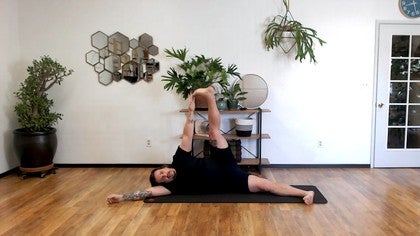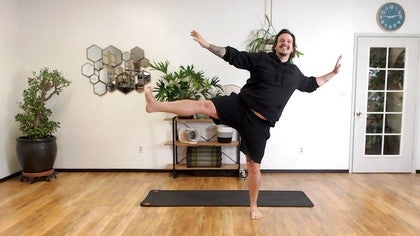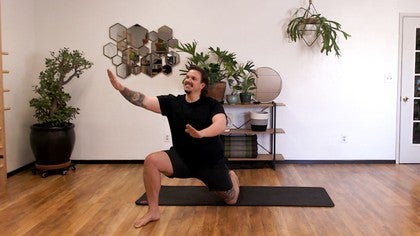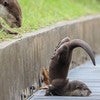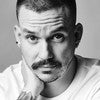Description
About This Video
Transcript
Read Full Transcript
Welcome back, everybody. Well, welcome back to my class. So this is week three of my eight-part series. I'm James. This is Pilates Anytime live, obviously, and this is the "Curious Movement" class.
So today we're gonna talk about presence and mindfulness and awareness and sort of how that fits in to a movement practice. But I want to take us back through the last two weeks. If what we're about to get into feels interesting to you, maybe dive deeper in weeks one and two, where we cover the nervous system and senses. But in the meantime, let's just go ahead and bring our hands together. We're gonna start off with some of our nervous system warmups, (sighs) and go forward from there.
So once your hands are warmed, go ahead and place them on the front of your throat and just be there, just fully relax, fully release, and just be with this experience. Couple of breaths. Just want you to notice what you notice as we go through this. When you feel ready, and by all means, if this feels so good for you to do, stay here and do this thing. I'm gonna move on.
I'm gonna have my right hand on my left throat. And as I drag it towards the middle, I twist my face in that direction. And then other side. Just kind of having a feel-good experience around the neck, around the throat. (breathes deeply) Gonna go into a little tapping here. And while we do the tapping, and I'm gonna talk while I do this.
You just enjoy your tapping. Your tap can go kind of all over the body. So today's class is sort of framed on the distinction between mindfulness and awareness. And what I want to talk about here is a very clear distinction. So let's take mindfulness for a moment.
Mindfulness to me, and we're gonna speak anecdotally, if you were in a new city, and you had been told, there was this really great. Maybe you go down into your legs and your back. You were told there was a really great restaurant somewhere. Well, you need the address to find that thing. Your goal is to find something.
Let's say you're in a new city, on the other hand, and you want to just drive around the city and see what's there, and you're like, "Oh, that looks like a cool place to visit." Oh, look at that. I didn't know that was over here." You're in discovery mode, and that's awareness. So awareness to me is all about discovery and just being open to possibility, open to potential. You're not trying to do or make something happen. Mindfulness is about finding the thing you want to find.
So if you want to make something happen or be aware of something, you're being mindful. Mindfulness always requires awareness. Awareness does not necessitate mindfulness. So as we go through this little tapping thing, I just want you to be aware of what it is you do feel. You're not trying to do anything.
You're just going like, "Well, what is this thing that I feel here?" Then we're gonna pick our hands up. We're gonna shake our hands as if we're shaking out the stress. Let that shake out the body. And you're not trying to do anything. You're just here having this experience kind of noticing whatever it is you notice.
Shake it all out, and then just be there. And just notice what you notice. Awareness because it is cultured out of us. We are not taught how to be aware in school. Awareness is a skill set that we have to cultivate.
So that's what we're doing today. What am I aware of in this moment? Now we're gonna go into some of our sensory warmups. Take one or two fingers and just snap. (snaps) You're just kind of locating how close, how far, listening. And then just be there.
See if you can listen to the sounds of your room. Maybe it's a car outside. Maybe it's someone in another room. Maybe it's the subtle hum of electricity somewhere. Bird sounds. I don't know.
You know what's in your room. Then we're gonna orient ourselves. Just kind of looking around your space, naming what's in the space, using your eyes, intaking that. For me, there's a ball and a bike and a door and a light and a computer and you all at home, a reformer, a trapeze table. And I'm just noticing what's in the room.
Noticing how it makes me feel. Noticing whatever it is that I noticed. Like, "Oh, how curious that I would notice a bike instead of logo." And then bringing yourself back to center. You can adjust the way you're sitting if you'd like. In today's breathing practice, we're gonna go into what's called the physiologic sigh.
Not gonna talk too much science about it, but it's been case studied after case studied in numerous labs to down-regulate or relax the nervous system. It's so, so, so easy and indiscriminate, you can do it anywhere. What you're gonna do. We do it naturally all the time. What you're gonna do is you're gonna take two inhales and then a long exhalation.
Preferential is if you can get the inhale through the nose and the exhale through the mouth, but you do what you need to do. Again, two inhales, maximum capacity, slow, relaxed, exhale. We're gonna do three. I'll demo what it looks like first. (breathes deeply) Now let's do three together.
Two quick inhales, one slow exhale. Before you start, take a little inventory. What do you feel? What do you notice? What feels important to notice right now? We're not being mindful of anything.
You don't have to do anything. You're just noticing, then two quick inhales. (breathes deeply) Notice any shifts. Notice if anything feels different or what you feel like noticing now. From there, let's just start rocking.
Just allowing the spine to move. For me, it's always about seaweed. That's the perpetual image for me. Can my spine be seaweed? Eventually, I want you to settle into a comfortable posture.
You do not have to be mindful of it being a perfect posture. Because the fact of the matter is there is no such thing as perfect posture. Posture is movement. So it should be in perpetual movement. The idea that, "Oh, something needs to be stacked, aligned," whatever it is, is simply not true.
It's just untrue. So eventually you're going to find something that feels comfortable for you. And if at any moment you want to shift it or move, that's up for you. What I'm gonna ask you to do is take a scan of your body. Now we are being a little mindful.
We're saying, "Instead of just noticing what I notice, what do I notice in the internal landscape of my body? How does my right foot feel versus my left foot? How does my right knee versus my left knee, the right hip versus the left hip, the belly versus the chest, the back body versus the front body? My hands, my elbows, my shoulders, my ears, my eyes, my brain, my tongue, my teeth, my jaw." Can you imagine, can you embody the shape of your bottom jaw, acknowledging that it's horseshoe shaped? Can you embody or be in your inner ear, your right inner ear?
What would it be like to be inside of that inner ear and look outward through the ear canal out of the right ear, like a tunnel dilating open? What is that experience like? How does it change what you're aware of? How about if you did it over on the left? Again you don't have to do anything.
Nothing is wrong, nothing is to fix. Simply just noticing what is, which is so valuable. And it the key stone, the foundation of what we're going to be doing today. So if you get nothing else out of today's practice, get this. Be with what we just did here.
Because everything else we do today is like adding endurance, adding resilience, adding fortitude onto this. I just want to mention I have a somatic meditation available on Pilates Anytime. I don't remember the class number. But it may be a good addendum to what you're experiencing today. So you can be with your body scan.
You can be here with any of these beginning exercises, the breathing, whatever makes you feel good, or you can follow me into the movement portion of today. All you're gonna do to start off is take your right hand over towards the left body. And you're just gonna touch, and then down. Left hand touches right body and touch. Right hand touches somewhere on the left.
Left hand touches somewhere on the right. Cross body touching. It's just that simple. I think of it as how many different places can one side of my body touch on the other side of my body. Again, I'm not telling you where to touch.
That's for you to decide. I'm just suggesting that there's a nervous system upgrade that goes on when one side of your body touches the other side of the body. Automatically, without having to do anything, your brain is going, (snaps) "I'm interested." Now, you can keep doing this thing, or you can move forward with me. I'm gonna choose to lie down now. And once I'm down, I'm gonna continue a very similar practice.
Just gonna be here noticing what I notice. Right hand touches somewhere on the left. Left-hand touches somewhere on the right. It's a task. Now rather than getting like, "Oh yeah, my toes and hands can definitely touch, right?" That's old thinking of hierarchy, and this is better than that.
We're not doing that anymore. Instead, how many different places on the right side can touch different places on the left side of my body? (blows) And then quiet it down. Just to be there. Give your nervous system time to intake what you just did.
We're gonna move now into big shapes and little shapes. It could not be easier. Bring your knees towards your chest, lift your head and make a little shape. If this is not available to you, make whatever little shape you can make. Then, in contrast, open it up, lie down, and make the biggest shape you can make.
Go little, go big. Go little, go big. Now, going little is, "Uh-oh, a bear walked into the room. How do I disappear?" Going big is mountain lion territory. I got to go big, go little, go big, go little, go big, go little, go big.
One more. Go little, go big, come back, settle into it. You'll notice, if you're a personality type that likes to be big in personality, going big is easy. Going small is hard. If you're an introvert, going big might be hard.
Might be something to practice, not just for your biology but also for your behavior. Now, once you're here, settling in, bring your knees into your chest again. Roll over to your left, and then roll over to your right. Roll over to your left. And can you go all the way to your left?
And then over to your right, and can you go all the way to your right? Just kind of noticing how that makes you feel, physically, emotionally, cognitively, are you comfortable falling to the right? Are you comfortable falling to the left? And if you need practice here, be here. Upgrade that portion of the movement before you move on with me.
Fall over to one side, make a little shape, then make a big shape over here. Go little, roll to the other side. Go big, go little, roll, go big. Go little, go big, go little. Can you make a different big shape?
Can you make a different little shape? Make a different big shape. Little and big. Come back to your center on your back. Just be here. Notice what you notice.
Lift your head, rolling forward and back. Now, you might want your feet to come down and come back. Again, what I urge you not to do is rolling like a ball. Please, we will get there. Right now, just roll like a human being.
Coming all the way up. Once you're here, make a big shape. Whatever that is for you. Make your little shape, roll back. Come up, make a big shape, little shape, roll, big shape.
Big shapes and little shapes as you roll. Now, that might be enough for you, or, what does it feel like if your feet never get to touch the floor? And you make a big shape. Big shapes. Now, remember, exercises are just tasks.
Movement is just a series of shapes, big shapes and little shapes. So if we start thinking of Pilates as tasks and shapes, what can this become? I don't know, for me, what if I make a big shape and try to touch my toes? Little shape, up, big shape, touch my toes. I don't know, maybe it looks like a teaser?
And maybe my teaser is one foot down. And I try to touch that toe or that one. Two more of doing whatever you're doing. Come up. (sighs) Just be there. Soft and relaxed. (groans) Now, we've already sort of begun the conversation of tasks. This was covered in week one.
Tasking, super simple. I'm gonna make one part of my body do something. I'm being mindful that what the task is is completed. Right? So my goal is gonna be right hand touches right toes, and back up.
Right hand touches left toes and back up. Left hand touches right. Left hand touches left. I can make it my knees. I can make it both hands.
It's for you to decide what is the thing that is staying still, what is the thing that is moving towards the still thing. Then we can get a little more particular. What if both hands tried to touch, and back up. Let's go back in to last week's. Can I just relax the neck?
And then maybe my eyes look up to bring me up. I relax my neck, My eyes bring me back up. Maybe I relax my neck and touch my legs, And then I'm up. And I'm up. Whatever it might be. We can change the task.
We can say hand reaches out in front of me. My hand stays still. How about my left foot touches my hand? How about my right foot touches my hand? Now, I don't need to keep perfect posture, because there is no such thing.
What we can think about is, what does my body need to do? And where do I want it to go? So this is really easy for me, right? Then I can go, "Well, how do I, if I value being up, where do I need to go? Maybe I need to do a twist." It's just learning to listen.
But in order to listen to your body, you gotta be aware of what information is coming in. What does it feel like? How do I contextualize and sense-make out of that other hand? I could go back into this task. Now, if that is difficult for you or you really enjoy that, be there.
I'm gonna open up my legs a wee bit wider. I'm gonna open my arms out to the side, and I'm gonna make the biggest shape I can make. I'm gonna stay in my very big shape, and I'm gonna create a task out of it. Right hand touches left toes. Big, big, big, big, big, even as I go down, I'm big.
And I'm back up. Other side. I'm just thinking, "Where am I being big? Am I being big in my hips? In my throat, in my hands?
Where am I small? And am I okay with that? Do I like feeling small in that? Maybe I want to make it small. Maybe I want it to be big." It's for you to decide, how do you want to be today?
What you want it to feel like? And make some decisions based on that versus right and wrong. Now, if you are a saw lover, keep doing that thing, okay? I'm going to take it into version number one of what I call break dancer. This is break dancer with, and make sure you got some space around you.
You're gonna need some space. Break dancer number one is tasking with the hands. So big shapes, right hand goes to touch left foot. It sweeps over to touch right foot. It reaches behind you as far as you can go, and it lays you down.
It comes up and over to touch your left foot. Touch your right foot. Reach behind you. It supports you to come down. Other side, I come up, touch, touch, switch hands.
Left hand touches right foot, touches left foot, reaches behind you to slide you down, up and over. How do you come up on this side to touch, touch, repeat. Big shape, big shape, big shape, up, big shape, big shape, big shape, big shapes. Version number one of break dancer. We've got to go through another exercise to get to version number two.
So lying down on your side. I don't care if you're propped, if you're lying down, if you're up on your elbow, you do you. You know what you need to do in order for it to feel like you want it to feel. Take an inventory, lift your top arm up. The task is my foot wants to come up and touch my hand.
And back down. Foot to the hand, foot to hand, foot to hand. One more. Then I'm just gonna switch where my hand is. Maybe it goes in front of me.
My foot touches my hand. Now, you may need to change your setup in order to make that happen. You may need to make a smaller shape. This might be really valuable to feel successful. You know what you need to do.
This is me advocating for you to make that choice. Then take that arm behind you. Foot touches. Good. From there, my arm reaches forward.
My foot reaches backwards. They are in opposition of one another. Then as my foot goes forward, my arm reaches backwards. Now, there are plenty of routes that arm can take. It can sweep down by the foot.
It could go over your head. It could bend and go forward. It's not about choosing the right way. For me, it's always about creating options in the body. Good, take a moment and rest.
Let's do the other side. Flipping over, however you get there, you get there. But once you're there, take a moment and check in. Don't just rush on to the next thing. We're cultivating awareness and experience so that we know how we want to be present.
That's presence, right? Top hand, foot, foot, foot, foot, and foot. Arm reaches in front. Foot, foot. Again, one more.
Arm reaches behind. Foot, foot. They move in opposition Think big shape. How far away from each other can they get? When they move to the other side, how far away can they get?
And again. One more of whatever it is you're doing there. Good. Now version two of break dancer. Version one was tasking with the hands.
Version number two is tasking with the feet. You're gonna need some space. So let's come out here a bit. And we're going to open our arms to the letter T, and we're just gonna be here. You can have your knees bent.
You can have your legs straight. It is your choice. From there, I'm gonna make the decision to keep my hands where they're at. I'm going to be mindful of that. That's a rule.
I'm going to take my left foot to touch my right hand. However it gets there. And I'm gonna come back, other side. Other side. Now, if this is a lot for your practice, be there with that, practice that, be with, like, how can I make that happen?
If you're ready for the next level, keep your legs straight, and do that. (breathes deeply) Good. From there, hah, let's go into break dancer number two. I'm going to have my right hand go over. It's going touch.
Left hand, left hand stays there. It's going to touch left foot, right foot. Try to come all the way back down. Left-hand then goes. It touches, touches, touches, touches, opens up.
Left foot touches, tries its best to touch, and comes back around to touch. Right, touch, touch, touch, touch. So you're just choosing a limb and making it touch the other three. Now, once you understand where you're going, you can add some fun into it, and it just kind of circulates. And you can even just sort of let go of the rules once you sort of understand them and just sort of play with that a bit.
We've got a whole play week coming up near the end. And you're just sort of windmilling your way around. Now, you can be there, or you can even try adding in some legs with that, where you're just taking and coming around. It becomes so much easier if you kind of know where you're headed. What is touching what?
And am I in a big shape or a little shape? Big shapes, touch, touch, big shapes, touch, touch. Big shapes. Just have some fun with it, hand up. Take an inventory. How do you feel?
What do you notice? What was that experience like for you? Where was it easy? Where was it hard? How would you qualify it?
How would you teach that? How would you explain it to someone? Then let's go touch our toes, lying back down. Sometimes after a really big movement, I like to bring it back in, kind of going, "I'm out here, now I'm here." So I'm just touching and coming back down. I can even push going up and over.
I could come down one side. I could come up through the middle and touch one foot. It's up for you to decide where your destination is and how you get there. What are you looking at? What are you feeling?
What are you listening to in yourself and in your practice? (sighs) And then up, let's just collect for a moment, go into some seaweed spine. So we've had quite a bit of nervous system waking up, being with, collect yourself. Listen, what do you notice? Rescan the body.
What's the experience in the feet? What is it in the spine? How about the backside of the body or the front side of the body? Are you more or less aware of where your hands and your feet are? So many things to just get curious and discover.
Where do you feel spacious in your body? Where do you feel less spacious, hm? Then let's go to hands and knees. Get yourself set up if you need some space. Go ahead and create some space for you.
But really begin to feel your fingertips sort of there they are. Feel my toes. There it is. Just gonna rock to the right, rock to the left. I feel my right hand and right leg. Then I'm really feeling my left.
I'm almost discovering side to side. There's that term again. I'm not trying to do something. I'm not going, "Am I aligned over here? What's my ribs doing?
Where's my head." Whatever. I'll find that eventually. Right now I'm just getting curious about what it's like to have a human experience in the moment. Find my center. I go forward. I go back. Now as we get into, I don't want to say harder skills, but just things that can get you aroused, get your nervous system riled up a bit.
You might want to bring back that physiologic sigh. You may need to pause and do a tap. Let yourself find your center. You know where right is. You know where left is, you know where forward and back is, and you're just gonna be there.
From there, my foot is going to create a task. My right foot is going to do its best to touch my left. My right foot is going to touch my right hand. That's what I want to say. And then it's gonna come back.
Other foot, left foot touches left hand. And back. For me, it intuitively brings forth a cat cow moment. Yours might be different. Now, you can continue to do that.
Or what is it like if you take your left arm, thread it through, balance down on that shoulder, right foot comes forward to touch. And then we're back up. Here we are again in that cross body touch. Right arm, left foot. And back up.
Left arm. Right foot. Right arm. Left foot. We're playing with balance. We're waking up the upper body as a balanced organizing system. One more each side.
Come back up, take an inventory. What does that feel like? What did you notice about that? Let's have a pushup moment. Maybe as you go through this, you want to incorporate favorite exercise from last week's session.
So here I am. I'm going to be on hands and knees. I'm gonna do what I call kitty cat pushups. So for kitty cat pushups, I want my feet off the floor. And I'm going to imagine that I've got a bowl of water, food, milk, whatever I want in between my two hands.
And I go down, and I come back up. Again, I'm just moving down and coming back up. You can stay there. Or you can imagining, imagining? (laughs) You can use your imagination, use your words, James, to bring the bowl of water forward X amount of inches, for you to decide. And go forward, and back up, forward, back up.
For me, I like to think, how far in front of me can I get that imaginary bowl of water? I have to stretch for it. Again. Two more of wherever you're at. Sit back, take your inventory, what did you notice?
What do you need to do? Now, I'm gonna have a Phillip Beach moment. Brilliant osteopath, movement educator, traditional Chinese medicine doctor from New Zealand. We're gonna do his match strike exercise. So we're gonna come up, and I'm gonna demo what this looks like from the side and then show you a front view.
I like to have my toes tucked. From there, right leg match strikes to come forward and back. I'll show you from the front. It is one leg coming straight through and back. What we're avoiding here, being mindful to move away from, is what I call hurdling.
This, where it's out to the side, right? Instead, we're looking for forward movement. So you can be here. You can let your arms mirror that if you'd like. I like to add in dynamic movement, meaning I go forward, I lunge, and I come back.
I'm just beginning to play with some balance. Remember, we had a whole falling practice. So if you go to fall, you've practiced that. And if you haven't, that's class one. Now match strike, hold, come all the way up, back down, match strike, other foot, down, down.
Other foot does the lead. And we're up. Spend a moment getting your balance. Just kind of figuring out where you're at in space. Gives me time to get water.
From there, orient. We're in a whole new way of being. We're standing instead of sitting. So I'm looking around, I might need to go into this. I might need. (breathes deeply) I might need this.
Whatever the case is, caretake that nervous system. From there, let's have a little fun. This is the MoveLab James interpretation of some archival standing work. 'Cause you know I'm not gonna give you classical. That's just never gonna happen.
So here's what I want you to do. We are going to. I'll turn to the side. We are going to pick our toes up, set them down. We're going to pick our heels up. Let them fall down.
Toes, heels, toes, heels. Now, you can stay there, or you can pick your heels up and drop them. You can let your knees bend, and you can get a little buoyancy. Can you let your whole body rebound and shake and move? Just kind of waking up everything.
Just let it move. There is no such thing as perfect posture. That might be a good mantra. That's gonna be my mantra for today, and then relax. (sighs) And be there. As we start, here's the conversation.
We are going to, okay, balance. This is a version of balance. Got it? This is also a version of balance. Dynamic balance, static balance.
None of them are more important. So if you find yourself needing to move, collect yourself, find yourself, orient yourself, and it looks like this, you are not doing it wrong. You are doing a version of balance called dynamic balance, helping you to find where you are in space. Your joints are learning. So there's no right or wrong here.
You've woken up your feet. There you go. We're gonna break this down into tasks. Open your arms to the letter T, make a great big shape. Bring your hand slightly in front of you.
Palms can go up. Palms can go down. It makes no difference to me. From there, we're gonna make it a task, right foot is going to do its best to touch right hand. Right foot is going to do its best to touch left hand. Other side.
Take a hand to touch. It truly makes no difference. I could do a bunch on this side. I could also make it look like that. And that's fine too.
I may need to make a smaller shape to just kind of prove to myself. I may need to hold onto something and do it. You're not doing it wrong. You're doing your version of whatever it is. Back to center. Really thin shape.
Go back into your bouncing. Now I can stay rigid or I can let it flop. Your choice. What do you want it to feel like? From there, can you start to make that a hop?
As you're hopping, can one foot touch your rear? Maybe I want a big shape. Maybe I just want to be here. Maybe I just want to practice here. Maybe I want a hand to touch.
Four, three, two, one. Ah, just be there for a moment. Notice what you notice. How do you feel? What feels alive? What are you aware of? Orient.
Ah, calm. Then we're gonna have a finishing practice. Humans, there is a natural human movement. It's called walking. So you're just gonna start walking around your space, wherever you'd like to go.
I want you to just notice what you notice as you walk. (breathes deeply) There's a plant and a light and a computer and a mat and some water. And I'm just noticing. I'm not gonna judge. I'm not gonna be mindful to do a walk.
I'm just simply walking. Then I'm gonna walk backwards, and I'm gonna notice whatever I notice. I would like, in my own body, more movement. So now I'm gonna be mindful of my upper body moving. I may then want to walk forward and back.
I may even want to walk sideways. Right now, you're just making up your own rules. Here we go. Posture and presence is determined by an internal state. Do I feel safe? What am I feeling?
What am I sensing? What's my emotional and cognitive sense? Proving the point. I want you to stand there. I want you to imagine you've just won the lottery.
Like the big lotto. You are worth a lot of money, and you can share it, and you can make a lot of people's dreams come true. Walk around like you've just won the lotto. You are worth a lot of money, and you can do a lot of amazing things with that money. In contrast.
Imagine you've just lost your house, a job, maybe even a loved one. Walk around the room in that emotional state. Which way is the right way to walk? Depends on what you're feeling, right? So walk around the room happy.
So happy that maybe you get a little skip. Maybe even skipping backwards or forward. Maybe it's even just a standing in place movement, something physical that tells you happiness is the goal. Then just be there. (sighs) Physiologic sigh without even trying. My nervous system knows what to do. (blows) What do you notice?
Do you feel big? Do you feel small? Are you okay with it? Just take a little inventory. What do you feel like inside? What do you notice on the outside?
How do you want to be for the rest of the day? It's a choice. It's up for you to decide and cultivate that. Life is gonna happen. It's about having the skillset to meet and interface with life and the human experience.
So we're gonna end class the way I always do. Put your hands on your heart. Tell yourself, "Thank you for showing up today." You did something really great for yourself. Take a look around your space. Tell your space, "Thank you." Even if there's obstacles and congestion in the room, you could not have moved the way you did today.
You could not have had the experience you had without your space. Tell your community, "Thank you." Dogs, cats, people in the room, people in the house, friends, family, people here, share this. Share your experience with others. We live in a community; we are interconnected. Thank you all.
We could not do this without you. Again, I'm James Crader. This is "Curious Movement." Stay tuned for more. We've got so much more, but thank you for showing up today. I and Pilates Anytime appreciate it.
Mindful Movement: Curious Movement
Comments
You need to be a subscriber to post a comment.
Please Log In or Create an Account to start your free trial.
